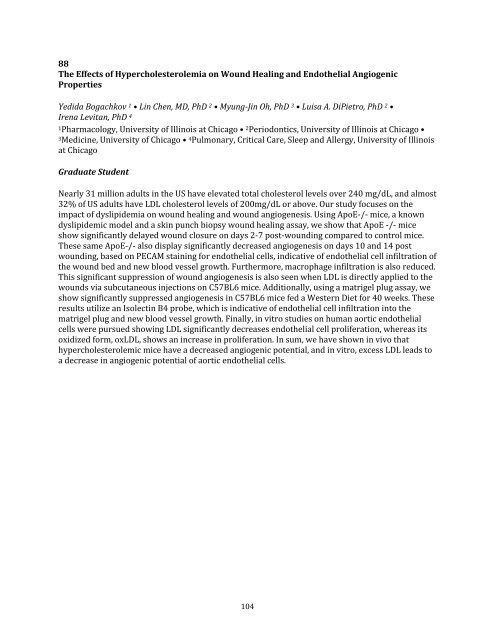2017 Cardiovascular Research Day Abstract Book
You also want an ePaper? Increase the reach of your titles
YUMPU automatically turns print PDFs into web optimized ePapers that Google loves.
88<br />
The Effects of Hypercholesterolemia on Wound Healing and Endothelial Angiogenic<br />
Properties<br />
Yedida Bogachkov 1 • Lin Chen, MD, PhD 2 • Myung-Jin Oh, PhD 3 • Luisa A. DiPietro, PhD 2 •<br />
Irena Levitan, PhD 4<br />
1Pharmacology, University of Illinois at Chicago • 2 Periodontics, University of Illinois at Chicago •<br />
3Medicine, University of Chicago • 4 Pulmonary, Critical Care, Sleep and Allergy, University of Illinois<br />
at Chicago<br />
Graduate Student<br />
Nearly 31 million adults in the US have elevated total cholesterol levels over 240 mg/dL, and almost<br />
32% of US adults have LDL cholesterol levels of 200mg/dL or above. Our study focuses on the<br />
impact of dyslipidemia on wound healing and wound angiogenesis. Using ApoE-/- mice, a known<br />
dyslipidemic model and a skin punch biopsy wound healing assay, we show that ApoE -/- mice<br />
show significantly delayed wound closure on days 2-7 post-wounding compared to control mice.<br />
These same ApoE-/- also display significantly decreased angiogenesis on days 10 and 14 post<br />
wounding, based on PECAM staining for endothelial cells, indicative of endothelial cell infiltration of<br />
the wound bed and new blood vessel growth. Furthermore, macrophage infiltration is also reduced.<br />
This significant suppression of wound angiogenesis is also seen when LDL is directly applied to the<br />
wounds via subcutaneous injections on C57BL6 mice. Additionally, using a matrigel plug assay, we<br />
show significantly suppressed angiogenesis in C57BL6 mice fed a Western Diet for 40 weeks. These<br />
results utilize an Isolectin B4 probe, which is indicative of endothelial cell infiltration into the<br />
matrigel plug and new blood vessel growth. Finally, in vitro studies on human aortic endothelial<br />
cells were pursued showing LDL significantly decreases endothelial cell proliferation, whereas its<br />
oxidized form, oxLDL, shows an increase in proliferation. In sum, we have shown in vivo that<br />
hypercholesterolemic mice have a decreased angiogenic potential, and in vitro, excess LDL leads to<br />
a decrease in angiogenic potential of aortic endothelial cells.<br />
104


